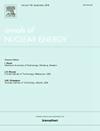Coupled reactor physics and thermal-hydraulics analysis of an SCW-SMR reactor concept – Part II: Improvement of the concept and sensitivity analyses
IF 1.9
3区 工程技术
Q1 NUCLEAR SCIENCE & TECHNOLOGY
引用次数: 0
Abstract
In the frame of the EU ECC-SMART project, the pre-conceptual design of a water-cooled small modular reactor operating at supercritical pressure (SCW-SMR) with seven heat-up stages is under development and assessment. The first part of the two-part paper presented the concept design, the models developed at BME in the Apros thermal-hydraulics system code and in the Serpent 2 Monte Carlo reactor physics code, the developed coupling methodology of these models, and the results of the first coupled calculations. This second part of the paper outlines the approaches adopted by the BME research team to improve the original design, primarily to reduce the high cladding temperatures. The effects of the increased mass flow rate and the introduction of inhomogeneous inlet orifices are thoroughly investigated and presented. Finally, a comprehensive sensitivity analysis has also been performed to demonstrate the robustness of the proposed design.
求助全文
约1分钟内获得全文
求助全文
来源期刊

Annals of Nuclear Energy
工程技术-核科学技术
CiteScore
4.30
自引率
21.10%
发文量
632
审稿时长
7.3 months
期刊介绍:
Annals of Nuclear Energy provides an international medium for the communication of original research, ideas and developments in all areas of the field of nuclear energy science and technology. Its scope embraces nuclear fuel reserves, fuel cycles and cost, materials, processing, system and component technology (fission only), design and optimization, direct conversion of nuclear energy sources, environmental control, reactor physics, heat transfer and fluid dynamics, structural analysis, fuel management, future developments, nuclear fuel and safety, nuclear aerosol, neutron physics, computer technology (both software and hardware), risk assessment, radioactive waste disposal and reactor thermal hydraulics. Papers submitted to Annals need to demonstrate a clear link to nuclear power generation/nuclear engineering. Papers which deal with pure nuclear physics, pure health physics, imaging, or attenuation and shielding properties of concretes and various geological materials are not within the scope of the journal. Also, papers that deal with policy or economics are not within the scope of the journal.
 求助内容:
求助内容: 应助结果提醒方式:
应助结果提醒方式:


